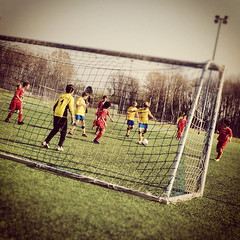 |
| Photo by @Mr_Schenk via eltpics |
About a month ago I took part in a debate entitled Teaching
Vocabulary: in or out of context where I was on the team defending teaching vocabulary in context. I hereby confess that on occasions I had to resort to unfair tactics to
win the debate. While making the case for teaching vocabulary in context, I argued,
for example, that the word goal should be taught together with either:
achieve
or
score
otherwise, there would be no way to distinguish
between the two senses of the word.
Or take the word key. How can you know, I argued, whether it is
a key to a door
a key on a keyboard
or
a key to solving the problem
In actual truth, what I was referring to is not
context of a word but rather its co-text.
I first came across the term co-text when
reading Michael Lewis's The Lexical Approach but later found out that it was
probably first used by Michael Halliday, a systemic functional linguist, who
distinguished between:
co-text – the linguistic environment of a word
context – the non-verbal environment in which a
word is used
Put another way, the surrounding
situation in which a word is used is its context whereas the surrounding words is its co-text, the most
obvious manifestation of which is collocations.
Do we need Amelia Earhart to provide context?
 |
| Image via Wikimedia Commons |
Let's look at it it in the context (!) of teaching. If
I were teaching the word goal in context I could use images (e.g. Nelson
Mandela) to evoke the life of a man who overcame difficulties in order to
achieve his goals. Or I could wait until the word goal came up in a text, for
example, the story of Amelia Earhart who was the first woman to fly across the
class with their life experiences and real world knowledge, and should be able to contextualise new vocabulary
themselves. Co-text, on the other hand, is important because the way words
behave differs across languages. To be able to use the word goal in English
learners would have to know the verbs that commonly occur with it, such as
achieve / set / accomplish or score (if talking
about football)
 |
| Photo by Shaw Girl on Flickr [CC BY-NC-ND 2.0] |
Likewise, if you're trying to explain the meaning of the verb to
chop as cutting something into pieces, learners may simply map chop onto a word in their L1 which means cut (in many languages both words are the same, e.g. Russian). It would therefore be wise to supply the words that frequently co-occur with chop:
onion, garlic, pepper
without recourse to a Youtube video of a cookery programme to provide the context.
Too much hype over context?
Many teachers unfortunately equate teaching
words in context with putting it in a sentence. This may not always be the most
effective way. One study showed (Webb 2007) that presenting new
vocabulary in single sentence contexts doesn't result in better learning of meaning or form. In
fact, presenting decontextualised words with their L1 equivalents proved more effective than presenting
new words in glossed sentences (two groups of learners were compared), even though the
difference wasn't statistically significant.
So to revisit the question raised at the
debate I took part in: whether I am really in favour of or against teaching vocabulary in context, I'd
say that new words - especially high-frequency items - should not necessarily be taught in context but they should almost always be taught with co-text.
References
Webb, S. (2007). Learning word
pairs and glossed sentences: The effects of a single context on vocabulary knowledge. Language
Teaching Research, 11, 63-81.
Comments
Post a Comment